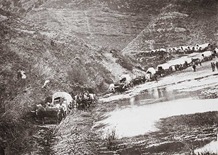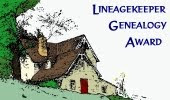I’ve written about publishing your family history work in the past. In the past few months, I’ve helped several people conceptualize the book layout that they hoped to create for their own families.
 Any of us can be a published author with little to no cost by using online digital publishing companies. You create the pages on your computer and then upload them to the online sites. They all offer tools to help you create wonderful family history publications that your family will cherish for years and years..
Any of us can be a published author with little to no cost by using online digital publishing companies. You create the pages on your computer and then upload them to the online sites. They all offer tools to help you create wonderful family history publications that your family will cherish for years and years..
Here are two of the sites to consider: Lulu.com and Blurb.com. Take a look at the books others have created, read user comments and check out the pricing on the sites. There are other sites available, so be sure to find the one that best fits your situation and expectations.
A thumb-through of existing genealogy books on the sites, will help you both visualize your book and give you some ideas of what makes a good family genealogy book. Here are examples from a publication on each site:
-
Example book on Blurb: http://www.blurb.com/books/1752245
-
Example book on Lulu: http://bit.ly/hR94j9
You can see the different styles of writing genealogists use when writing their books. The Barber book (Blurb.com) was written by someone who was gifted at writing family stories and then supported his text with reports from his genealogy program, photos of people, places, their environment and their tombstones. The few preview pages of the Batten book (Lulu) show that the author used reports from their genealogy program sprinkled with photos.
The focus of the two books differs in that the Barber book focuses on a limited number of generations while the Batten book covers many more generations but looses the detailed story text represented in the Barber book.
The choice of writing styles depends on the amount and type information that the author wants to convey to their readers. What style will you choose for your project? It all depends on your audience and the information you are trying to convey to them.
Close and extended family constantly ask me for a report of their lineage. Depending on the ancestral lines that we have in common, the book type reports may be several hundred pages to 4,000 - 5,000 pages long. I use Legacy software to create the reports and send them as .pdf file attachments on emails rather than printing them to hard copy. The reports are “OK - to - great” depending on how much time I take to interject written stories, text, photos, documents and other information as compared to the basic formatting from Legacy. The same files can be used in publishing a book from one of these vendors.
Using one of the on-demand publishing companies will save you a lot of money in setup costs and you don’t have to make a minimum purchase out of pocket. Pricing of the books automatically covers the printing costs and any additional profit you decided to include can help fund continued research.
We all encounter hard-to-read documents in our research. Handwriting Tutorials from BYU are online for no cost in English, German, Dutch, Italian, French, Spanish and Portuguese.
If you have Scots ancestry and struggle reading the old handwriting, visit the Scottish Handwriting site and read their tutorial. When you finish, you’ll be a Scots handwriting Wiz or at least substantially more proficient in reading them.
 If you have Mormon ancestors, be sure to check out all of the sources and reference information on the Mormon History site at BYU. Subject Librarian, Mike Hunter, has assembled an impressive collection of resources to help using our research.
If you have Mormon ancestors, be sure to check out all of the sources and reference information on the Mormon History site at BYU. Subject Librarian, Mike Hunter, has assembled an impressive collection of resources to help using our research.
Continuing with the Mormon ancestor research theme, be sure to look for your ancestors on the Mormon Migration passenger list. Also, remember to look for them on the Mormon Pioneer Overland Travel, 1847-1868, and on Mormon Pioneer Census Search.
Lastly in this focus group, we’ll round out the Mormon list with the Mormons and Their Neighbors site and the ever impressive Early Latter-day Saints site.
Site Pick of the Week: The Library of Congress Digital Newspapers. I worked on digitizing newspapers for this site for a few years and intimately know how much work goes into creating these great records. A few years ago, I interviewed the last Editor of the American Fork Citizen, Lehi Free Press and Pleasant Grove Review about his years of working at these locally “newsy” papers. When I mentioned that I’d always wanted copies of all the issues of the Citizen because so many of my ancestors were mentioned in it, he stated that all of the copies of all three of these publications were put in the trash can when they were purchased by a national newspaper company.
He was sick about it. We commiserated that he and I had not gone dumpster diving to retrieved them. Even though many of the issues are found in the BYU library, a full collection is almost impossible to find. At least it was hard to find until the LOC published them recently on their site.
Searching these wonderful old, often “chatty” publications for information about your family should be an integral part of any ancestral research effort.








